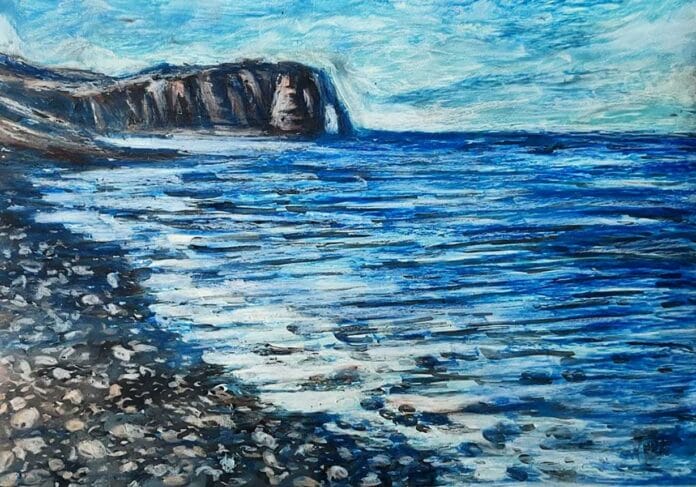Horus Artwork is a contemporary artist based in Germany whose creative practice embodies a deep dialogue between technique, subject, and imagination. Over the years, his artistic journey has evolved into a distinctive style that bridges classical craftsmanship with a modern sensibility. Working with oil and acrylic paints, as well as chalk and charcoal, Horus brings a tactile, layered quality to his works that both honors tradition and pushes into new creative realms.
At the heart of his practice lies an enduring fascination with nature and historical artifacts. For Horus, these elements are not simply subjects but living legacies, reminders of humanity’s shared past and enduring relationship with the natural world. His works invite viewers to reflect on how the traces of history and the raw power of nature continue to shape contemporary life.
Horus’s art does not merely record or replicate reality. Instead, it transforms the everyday into an imaginative playfield. His creative process embraces chance as much as intent, allowing intuition and spontaneity to guide the brush. In this way, the works unfold as visual dialogues, where structure meets unpredictability and observation gives way to poetic interpretation.
Normandy, 2025: A Meditation on Nature’s Power
One of Horus Artwork’s most evocative pieces, Normandy, 2025, captures the raw and elemental spirit of the French coast. On the surface, the painting depicts a stormy day on the Normandy shoreline, yet its essence extends far beyond simple representation. The work embodies a meeting point between memory, myth, and sensory experience.
The composition is built around contrasts: the restless motion of the sea against the immovable presence of the cliffs, the shifting light against the solidity of the rocky shore, and the fleeting spray of waves against the timeless horizon. Through this interplay, Horus creates a tension that is both dramatic and meditative.
The viewer is immediately struck by the intensity of the colors. The deep blues of the waves command the canvas, their swirling energy amplified by thick, sweeping strokes of paint. These waters crash against cliffs that rise like ancient guardians, solid, dark, and resolute. At the shoreline, gray pebbles scatter into subtle textures, their stillness disrupted by the constant rhythm of waves retreating and returning.
Light becomes an active participant in the painting. Reflected in sprays of water and hinted at in the sky, it dances across the surface, shifting from brightness to shadow in quick succession. This dynamic interplay of light and movement creates not only a visual drama but also a sense of time suspended, a fleeting storm that feels eternal.
Between Realism and Poetry
While Normandy, 2025, is grounded in a recognizable landscape, it transcends realism. Horus does not simply document the scene but interprets it, imbuing it with a poetic resonance. The cliffs and sea become more than geological features; they emerge as metaphors for resilience, impermanence, and the eternal struggle between permanence and change.
The painting carries a sense of narrative without explicitly telling a story. It allows the viewer to enter into the moment and experience its rawness, yet also to contemplate its symbolic dimensions. The coast becomes a mirror of human existence, at times turbulent, at times still, always in flux.
Horus’s use of texture amplifies this effect. In areas, the paint is thick, almost sculptural, echoing the weight of the cliffs. Elsewhere, the strokes are fluid and transparent, capturing the fleeting shimmer of spray or the translucence of light breaking through clouds. This tension between solidity and ephemerality lies at the core of the work’s power.
Artistic Philosophy and Process
Normandy, 2025, also exemplifies Horus’s broader artistic philosophy. For him, art is not simply about creating a static image but about engaging in an ongoing conversation with the subject. Nature, history, and chance all become participants in the process.
The artist acknowledges the role of unpredictability, the way paint may behave differently on canvas, or how a gesture might lead to unexpected forms. This openness to chance does not undermine control but enriches it, producing works that feel alive, dynamic, and unrepeatable.
In embracing this approach, Horus echoes the spirit of both ancient traditions and modern abstraction. Just as historical artifacts carry traces of human creativity across centuries, his paintings seek to capture moments that transcend the present, images that root themselves in memory while sparking new interpretations for each viewer.
Legacy of the Landscape
Landscapes have long held a central place in the history of art, from classical depictions of pastoral scenes to the Romantic era’s dramatic visions of nature’s power. With Normandy, 2025, Horus continues this tradition while pushing it into contemporary discourse.
The Normandy coast itself is steeped in history, from its ancient geological formations to its role in world events. In Horus’s painting, these layers of history become implicit, woven into the landscape’s character. The cliffs are not only natural forms but also symbols of endurance; the stormy sea not only a natural phenomenon but also an allegory of human struggle and resilience.
By situating his work within this context, Horus invites viewers to see landscapes not as passive backdrops but as living entities that shape and reflect human experience.
Conclusion
Horus Artwork stands as an artist deeply attuned to the intersections of nature, history, and imagination. His works, whether created in oil, acrylic, chalk, or charcoal, speak to the enduring power of visual art to transform the ordinary into the extraordinary.
Normandy, 2025, is more than a seascape it is a meditation on impermanence, strength, and beauty. Through its dynamic contrasts, tactile textures, and poetic atmosphere, the painting captures not only a storm on the French coast but also the timeless rhythms of existence itself.
In every brushstroke, Horus reminds us that art is not merely about seeing but about experiencing, entering into a dialogue where the past and present, the real and the imagined, converge. His work continues to evolve, but its essence remains constant: a profound engagement with the world around us and a call to perceive its hidden poetry.


